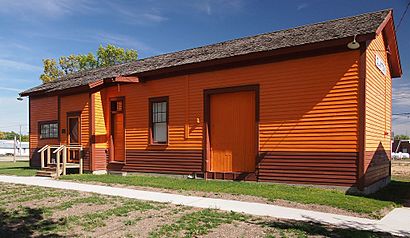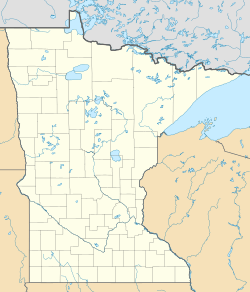Clinton station (Minnesota) facts for kids
Quick facts for kids
Clinton
|
|||||||||||
|---|---|---|---|---|---|---|---|---|---|---|---|
| Former Milwaukee Road passenger rail station | |||||||||||

Clinton's Milwaukee Road depot from the southwest
|
|||||||||||
| Location | Main Street, Clinton, Minnesota 56225 | ||||||||||
| History | |||||||||||
| Opened | July 2, 1884 | ||||||||||
| Services | |||||||||||
|
|||||||||||
|
Chicago, Milwaukee, St. Paul and Pacific Depot
|
|||||||||||
| Location | Clinton, Minnesota | ||||||||||
| Built | 1885 | ||||||||||
| Architect | Chicago, Milwaukee, & St. Paul R.R. | ||||||||||
| NRHP reference No. | 86002118 | ||||||||||
| Added to NRHP | July 31, 1986 | ||||||||||
The Clinton Depot in Clinton, Minnesota, is a really old train station. It used to be called the Chicago, Milwaukee, St. Paul and Pacific Depot. Today, it's a cool local history museum where you can learn all about the Clinton area.
This historic building was added to the National Register of Historic Places in 1985. Inside, you'll find shiny hardwood floors and fancy wooden panels in the waiting room. There's also an old office and a big room where freight (goods) was stored. The museum has lots of interesting things like military items, farm tools, train souvenirs, old photos, and newspapers from Clinton's past.
Contents
The Clinton Depot: A Journey Through Time
How the Train Line Started
In 1883, a company called Fargo and Southern railroad built a loading platform. It was two miles south of Clinton and was named Rupert. Just two years later, they moved their station right into Clinton. For a while, it was even called Batavia.
The Fargo and Southern company built their train line in 1884. It stretched from Ortonville all the way to the South Dakota border, passing through Clinton. In 1885, a bigger company, the Chicago, Milwaukee, St. Paul and Pacific Railroad, bought this line.
First Trains and Daily Stops
The very first train to travel the entire line ran on July 2, 1884. Imagine that! From 1885 until the late 1920s, the Clinton Depot was a busy place. Four trains stopped there every single day.
In the mornings, there were freight (cargo) and passenger trains heading north to Fargo. In the afternoons and evenings, trains would come through heading south. It was a vital hub for travel and trade!
Sending Messages: The Telegraph
Fast Communication in the Past
At the Clinton Depot, there was a sign that said "Western Union Telegraph Office." Train stations weren't just for trains; they were also important communication centers. Railroads helped carry mail and newspapers, but they also offered a super-fast way to send messages: the telegraph.
The people who worked at the depot, called depot agents, had to be skilled telegraphers. They sent messages for the railroad and also for anyone in the public who needed to send a telegram. Before phones were common, telegrams were the quickest way to share news, do business, or send personal messages. People used them a lot until the late 1940s.
Telegraph Operators at Clinton
J.P. Pratt became the depot agent in 1891. He had learned how to use a telegraph before coming to Clinton. While Mr. Pratt worked there, a young man named Frank Petrick became interested. Frank learned the special Morse code and how to operate the telegraph from Mr. Pratt.
Frank Petrick started working as the depot agent in 1901. He stayed in that job for a long time, until he retired in 1945. For many years, business was so busy that Frank's wife, Alice Condit Petrick, worked as his assistant from 1909 to 1934.
The End of an Era
Changes to Train Service
Daily train service at the Clinton Depot continued until May 1930. That's when Sunday passenger trains stopped running. After 1932, a freight train with just one passenger car offered "mixed service" (carrying both cargo and people) until 1956.
The Milwaukee Road, the big railroad company, stopped running its main passenger trains on December 16, 1968. These trains used to travel all the way from Chicago to Tacoma, Washington. Soon after, the Clinton Depot officially closed on December 12, 1969.
Tracks Removed
The entire train line was finally closed on March 1, 1980. About a year later, the tracks were completely removed. By 1980, the Chicago, Milwaukee, and St. Paul Railroad company was having financial trouble. Keeping the train line open would have cost a lot of money.



